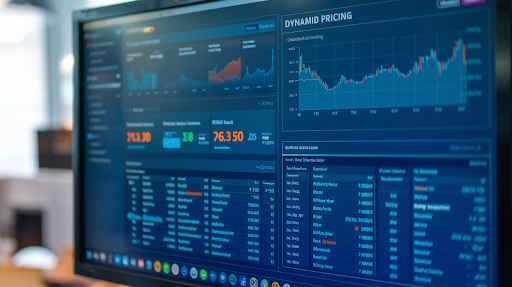In the fast-moving world of e-commerce, pricing is one of the most crucial factors influencing sales and profitability. Retailers who manually adjust their prices struggle to keep up with market fluctuations, competitor strategies, and shifting consumer demands. Pricing decisions are often reactive rather than strategic, leading to missed opportunities for revenue optimization.
Moreover, consumers today have access to a wealth of pricing information at their fingertips, making it easier than ever for them to compare prices across multiple webshops. A static pricing model makes it difficult for retailers to remain competitive, especially when competing against larger players who use advanced pricing algorithms. Fortunately, product management software equipped with dynamic pricing features takes the guesswork out of setting optimal prices, ensuring retailers remain competitive and maximize revenue with ease.
The challenge of static pricing in a dynamic market
Webshops that rely on fixed pricing often experience missed opportunities. Whether prices are too high or too low, the consequences are costly. Overpriced products drive potential customers away, while underpriced items eat into profit margins. Manually tracking price changes across hundreds or thousands of SKUs is not only time-consuming but also ineffective in today’s data-driven market.
For example, consider an online electronics retailer selling smartphones. If a competitor lowers the price of a popular model, customers will likely shift their purchases to the competitor’s site. Without real-time price monitoring and adjustments, the retailer may lose significant sales. Conversely, if a certain product is in high demand due to a trending social media post but remains priced the same, the retailer misses the chance to capitalize on increased willingness to pay. This lack of agility in pricing decisions puts businesses at a disadvantage against competitors who leverage automated pricing tools.
Product management software with dynamic pricing capabilities eliminates these inefficiencies by providing real-time insights and automated adjustments. This ensures that pricing decisions are always based on the most relevant and updated data, allowing retailers to operate with greater agility.
How dynamic pricing enhances growth
Dynamic pricing enables retailers to make data-backed pricing decisions without constant manual intervention. By leveraging algorithms and market data, product management software can adjust prices based on various factors, such as competitor prices, demand trends, seasonality, and inventory levels.
For instance, during peak shopping seasons, demand for certain products surges. A webshop using dynamic pricing can automatically increase prices in response to high demand, maximizing profits. Conversely, when demand slows or competitors lower their prices, the software can reduce prices to remain competitive. This level of flexibility is impossible with static pricing models.
Real-time data: the key to smart pricing
Having access to updated and relevant data is the foundation of a successful dynamic pricing strategy. Product management software continuously collects and analyzes data from various sources, including competitor websites, sales trends, and customer behavior. This data-driven approach allows webshops to:
- Detect pricing trends and adjust accordingly.
- Respond instantly to competitor price changes.
- Align pricing with real-time market demand.
- Improve inventory turnover by adjusting prices for slow-moving products.
Without this automated process, retailers would need to monitor competitors manually, risking delayed reactions and lost sales. With dynamic pricing features, webshop owners can confidently price products based on the latest market conditions.
Reducing workload while maximizing efficiency
A key benefit of product management software is that it significantly reduces the workload of webshop managers. Instead of manually tracking market trends and modifying prices, retailers can rely on automated pricing adjustments. This frees up time to focus on other critical areas, such as customer service, marketing, and product expansion.
Additionally, the risk of human error is minimized. Manual price changes across an extensive catalog can lead to inconsistencies or mispricing, potentially harming profit margins or brand reputation. Automation ensures pricing remains accurate and strategically optimized at all times.
Enhancing profitability with pricing strategies
Dynamic pricing is more than just reacting to market changes—it allows retailers to implement strategic pricing models tailored to their goals. Some of the most effective strategies supported by product management software include:
- Competitive pricing: Adjusting prices based on competitor activity ensures a webshop remains competitive while avoiding unnecessary price wars.
- Demand-based pricing: Prices fluctuate based on demand levels, maximizing profits during peak periods and attracting customers during slower sales cycles.
- Time-sensitive pricing: Retailers can introduce limited-time price changes to encourage immediate purchases, increasing conversion rates.
- Inventory-based pricing: Prices automatically adjust based on stock levels, reducing excess inventory or optimizing high-demand items.
By leveraging these strategies, webshops can create a pricing model that aligns with both their profitability goals and market realities.
Building customer trust with fair pricing
While dynamic pricing is a powerful tool, it must be implemented responsibly to maintain customer trust. Sudden, extreme price fluctuations can frustrate shoppers and lead to abandoned carts. Product management software allows retailers to set pricing rules and thresholds, ensuring that price changes remain within reasonable limits.
For example, a retailer may choose to prevent prices from increasing by more than 10% in a single adjustment or implement a minimum price threshold to protect profit margins. This level of control ensures that pricing remains competitive and fair, fostering long-term customer loyalty.
Consider a customer who frequently purchases groceries from an online retailer. If they notice that the price of an essential item like milk fluctuates drastically from one day to the next, they may lose trust in the retailer and seek a more stable pricing experience elsewhere. However, by setting fair pricing limits, the webshop can ensure that changes remain reasonable, keeping customers satisfied while still benefiting from dynamic pricing strategies.
The future of pricing in e-commerce
As e-commerce continues to evolve, the role of data-driven pricing will only become more critical. Retailers who embrace product management software with dynamic pricing capabilities gain a significant advantage in an increasingly competitive market. With automated adjustments, real-time data insights, and strategic pricing models, webshops can optimize their pricing effortlessly—driving revenue growth and improving overall efficiency.
Instead of relying on outdated, static pricing models, modern retailers can harness technology to stay ahead of the competition. The ability to adapt to market changes in real-time is no longer optional—it’s essential for sustainable success in the digital marketplace.






